My 18th century jacket is finally finished! Yay! I sewed the last two seams just some minutes before we took the photos! 😉 This type of 18th century jacket is called a bedgown, short gown, unlined caraco or manteau de lit. Short gowns were considered undress in the 18th century. Undress or informal wear – the everyday clothes of the 18th century – was worn around the house while doing the work.
I used an old bedsheet which I were gifted because I liked the washed-out color and the linen-like texture of the old, torn sheet. The bedsheet was a lovely pale shade of apricot. But, unfortunately, the middle part was very thin and badly torn. So I had to cut it away. There wasn’t much good fabric left, so I thought I’d use it as pattern-making fabric. But while making a pattern for medieval or renaissance bias-cut fabric stockings, I thought the fabric was too lovely to waste it like that.
So inspired by this 1740s painting by Chardin, this 1720s painting by Ceruti, this pretty apricot-colored, unlined, 18th c reproduction jacket, this peach striped linen reproduction round gown and this antique, late 18th century, plain, pieced shortgown, I thought I’d try if there’s still enough fabric for an 18th c caraco. Pink and flesh color was worn in the 18th century (source). Madder was used to dye fabric red or pink in the 18th century and pink fabric would’ve been cheaper than red fabric.
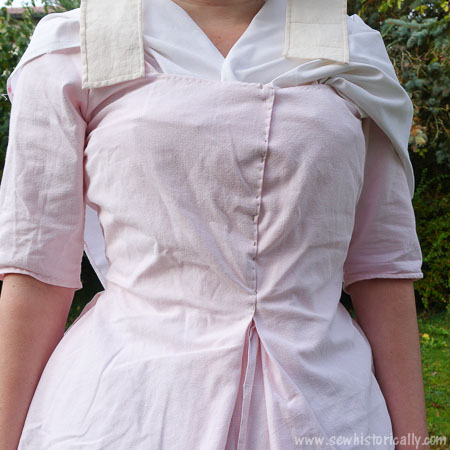
Here are 1760s instructions by Garsault how to make an 18th century bedgown or shortgown: The shortgown has inverted pleats at the sides and pleats at the front like mine. This 18th century cotton caraco at the Met museum also has similar pleats at the front and sides. An 18th century shortgown can be lined or unlined (source): mine is unlined.
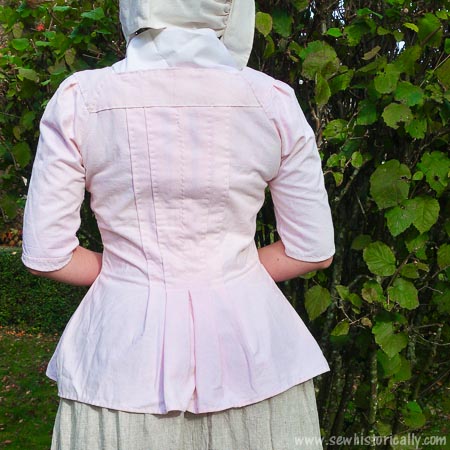
The pleats at the back are called en fourreau pleats. I’ve never before sewn 18th century en fourreau pleats. But they were easier to make than I thought. And they are such a pretty detail! They also stiffen the back of the 18th century jacket which helps to keep the back flat. Here at the MET museum are two 1770s silk Robe à l’anglaises with en fourreau pleats: beige 1770s Robe à l’anglaise and blue 1770s Robe à l’anglaise.
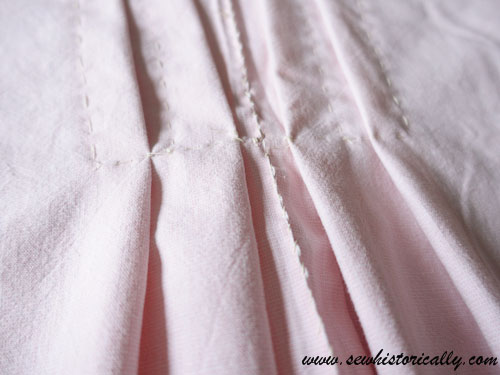
I used 18th century period sewing techniques: mostly running and overcast stitches. I used butted seams where two selvedges met. And for the side seams I used flat-felled seams which were also called plain fell, felled seam, hemmed fell, run and fell seam or overhand fell – a seam which was used in the 18th century when two raw edges met.
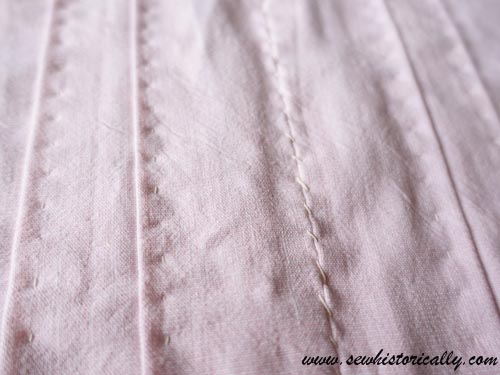
In the 18th century, linen thread was used to sew linen or cotton clothes (source): I used half-bleached linen thread.
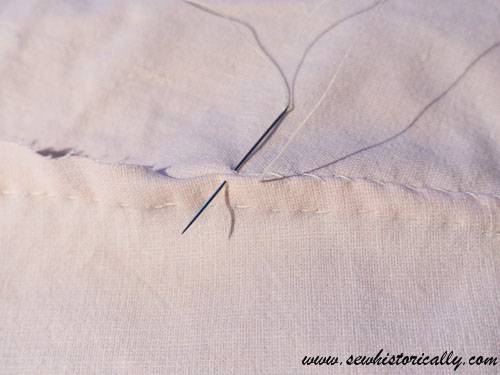
I had to piece the fabric because there wasn’t much left, and the leftover fabric wasn’t very wide – but that’s period accurate (source). But most of the piecing is hidden: The back piece is joined by a middle seam, and I had to add extra fabric for the side pleats.
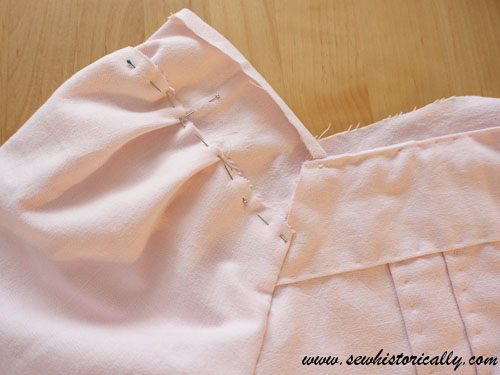
I’ve never before set sleeves the 18th century way, but here’s a great tutorial how to set in 18th century sleeves.
The bedgown fastens down the front with pins. 18th century gowns were usually closed with pins, hooks and eyes or spiral lacing.
By the way, I forgot to pack my fichu for the photoshoot and had to use a bed sheet instead! 😀 Shhh, don’t tell anyone, lol! 😉
I wear the short gown with my 18th century linen skirt and my handsewn 18th century lappet cap.
Related: Handwoven 18th Century Stays
I like how my 18th century bedgown turned out and it’s really comfortable to wear.
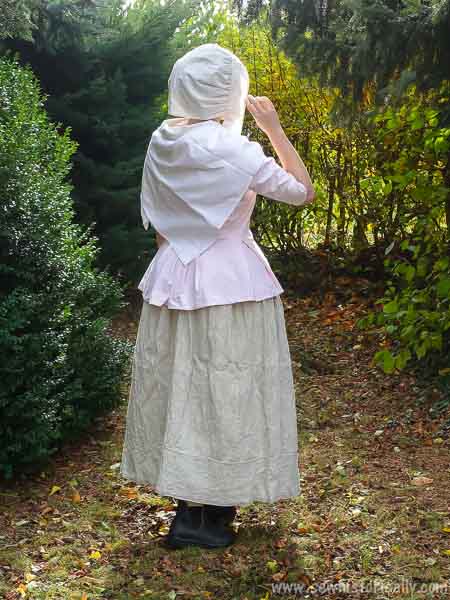
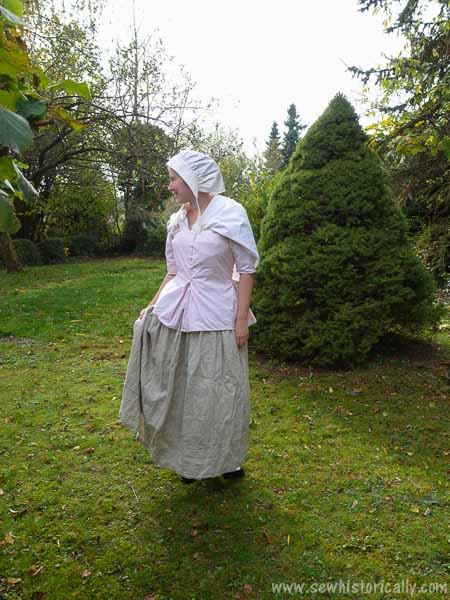

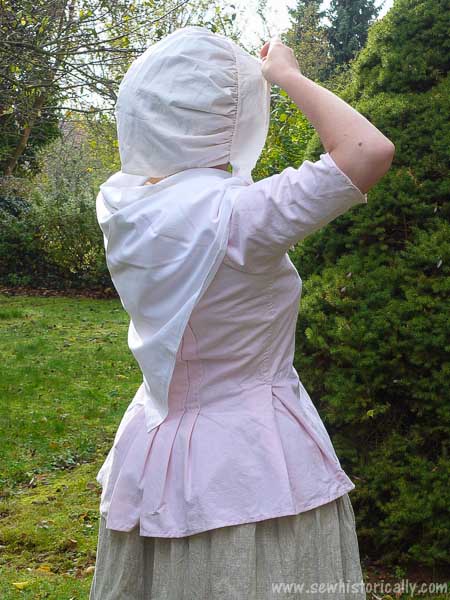
I love the tucks down the back! Do you make your own patterns, or buy vintage ones? You look so darling in this outfit! Thanks for sharing with SYC.
hugs,
Jann
Thanks Jann! 🙂 I make my own patterns.
Hello Linda,
I want to get into historical sewing, and I have one pattern for a Short Gown. The instructions do not mention if the Short Gown is to be lined or not, and if they are lined, would it be flat or bag lined?
Thank you,
Sandie
Both lined and unlined short gowns existed in the 18th century. My short gown is unlined. If you want to line it, in the 18th century the lining and outer fabric were usually treated as if it was just one fabric (flatlined). Instead of flatlining, the English stitch seam was also often used. Hope this helps! 🙂
I love this look Lena, especially from the back. Those en fourreau pleats are so flattering. Just one question though, don’t the pins stab you in the tummy when you bend down?
Thanks Michelle! You wear a chemise, stays and fichu underneath, so no, the pins don’t stab you in the tummy! 😉
It’s always fascinating to read your explanation of how these vintage styles work – thanks so much for sharing with Party in Your PJs!
Thanks Lynda!
This looks amazing, I’m so impressed with the beautiful vintage outfits you are able to produce. Just lovely.
Thank you Julie!
I am in awe of your sewing skills and love your explanation. I was mesmerised by the old world look and how well it suits you. The jacket is very interesting with the way it joins at the front and the please at the back. I really enjoyed this and thanks for sharing with us at The Blogger’s Pit Stop – Debbie from Deb’s World
Thanks Debbie! 🙂
Pretty! I admire your skills. Thanks for joining the To Grandma’s House We Go link party!
Thanks for stopping by!
Beautiful and graceful vintage outfit. The details along the back are gorgeous. You are obviously very gifted.
Thanks Leanna!